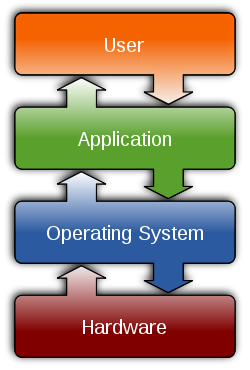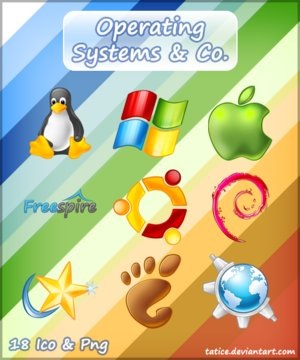What is OPERATING SYSTEM?
.: OPERATING SYSTEM
An operating system (sometimes abbreviated as "OS") is the program that, after being initially loaded into the computer by a boot program,
manages all the other programs in a computer. The other programs are called applications or application programs. The application programs
make use of the operating system by making requests for services through a defined application program interface (API).
In addition, users can interact directly with the operating system through a user interface such as a command language or a graphical user interface (GUI)
Components of the operating system
The operating system comprises a set of software packages that can be used to manage interactions with the hardware. The following elements are generally included in this set of software:
- The kernel, which represents the operating system's basic functions such as management of memory, processes, files, main inputs/outputs and communication functionalities.
- The shell, allowing communication with the operating system via a control language, letting the user control the peripherals without knowing the characteristics of the hardware used, management of physical addresses, etc.
- The file system, allowing files to be recorded in a tree structure.

Operating systems can be classified as follows:
- Multi-user : Allows two or more users to run programs at the same time. Some operating systems permit hundreds or even thousands of concurrent users.
- Multiprocessing : Supports running a program on more than oneCPU.
- Multitasking : Allows more than one program to run concurrently.
- Multithreading : Allows different parts of a single program to run concurrently.
- Real time: Responds to input instantly. General-purpose operating systems, such as DOS and UNIX, are not real-time.

Which OS's are available?
Windows
is the name of a family of operating systems created by the Microsoft Corporation for use with personal computers.
Windows employs a graphical user interface (GUI), which eliminates the need for the user to learn complex commands.
With a GUI, the user instructs the operating system by using a mouse to point and click icons that are displayed on the screen.
Microsoft Windows, first released in 1985, was originally designed as a GUI for DOS, which uses the command-line approach.
In order to communicate with the computer, DOS users must type commands or instructions at the command prompt,
and then the command-line interpreter executes those commands. The term "DOS" can refer to any operating system,
but it is frequently used as a synonym for Microsoft Disk Operating System (MS-DOS). DOS has limited use with modern computer systems
and applications because it does not support multiple users or multitasking. Some of the other operating systems,
including Windows, can also execute DOS-based applications. Today, most DOS systems have been replaced by more user-friendly systems that use a GUI.
Windows 3.1 was released in 1991.
Windows 95 in August 1995.
With each new release, from Windows 98 to Window 2000 to Windows XP, Microsoft gained popularity.
Today, almost every new personal computer comes preloaded with the Windows operating system.
Windows can be run on practically any brand of personal computers.
It is estimated that 90 percent of personal computers run the Windows operating system.
The remaining 10 percent run the Macintosh operating system.
UNIX is a multi-user, multitasking operating system, and was designed to be a small,
flexible system used by computer programmers. Since UNIX was designed to be used by programmers,
it is not considered to be very user-friendly for the average person.
However, graphical user interfaces have been developed for UNIX to help alleviate the ease-of-use issue.
Linux is a UNIX variant that runs on several different hardware platforms. Linus Torvalds, a student at the University of Helsinki in Finland,
initially created it as a hobby. The kernel, at the heart of all Linux systems, is developed and released under the General Public License (GNU),
and its source code is freely available to everyone. There are now hundreds of companies, organizations, and individuals that have released their own versions of operating systems based on the Linux kernel.
Because of its functionality, adaptability, and robustness, Linux is able to compete against the Unix and Microsoft operating systems.
IBM, Hewlett-Packard, and other computer giants have embraced Linux and support its ongoing development.
More than a decade after its initial release, Linux is being adopted worldwide mainly as a server platform.
More and more people are starting to use Linux as a home and office desktop operating system. The operating system can also be incorporated directly into microchips in a process called "embedding."
Many appliances and devices are now starting to use operating systems in this way.